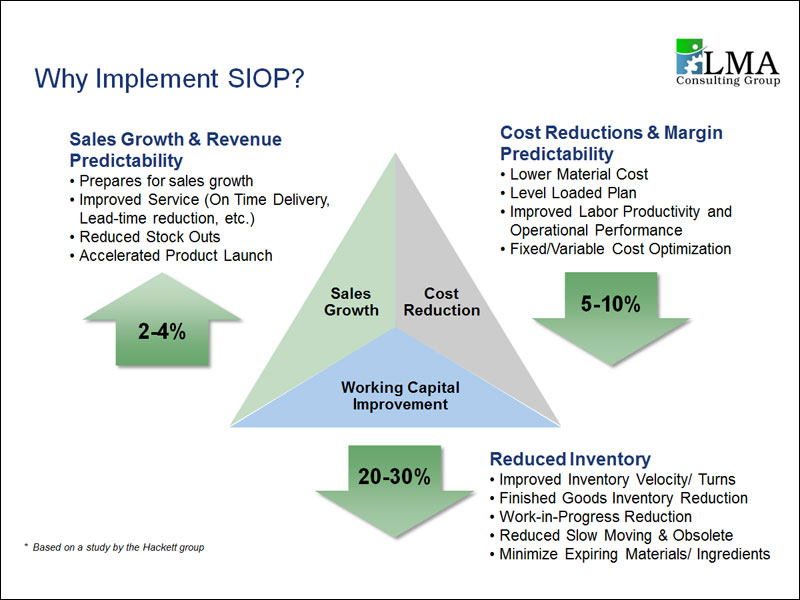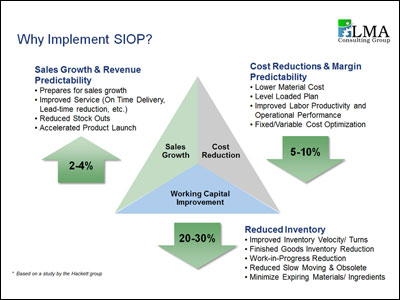
Are you concerned about inflationary pressures?
Implementing a SIOP process will provide quick access to changing sales volumes and prices as well as manufacturing and supply chain requirements and costs so that you can make directionally correct informed decisions to mitigate inflationary pressures. For example, you could buy ahead for a critical material you expect to incur inflationary pressures.
Are you struggling to keep up with customer orders?
A SIOP process will allow you to gain a directionally correct view of customer demand so that your operations, supply chain, and finance resources can get ahead and put plans in place to make sure that products will be available when customers expect delivery. With a view into future needs, preparations can be made to stay on top of customers’ needs.
Are your Sales limited by your Operations Team’s inability to fulfill orders on time?
A key benefit of the SIOP process is the ability to see what future demand is coming down the pike, and more importantly, how that demand translates into engineering, manufacturing, purchase, and distribution requirements. By gaining this view into requirements, Operations teams have the ability to prepare so that orders can be fulfilled with high OTIF (on-time-in-full) levels and with short lead-times.
Is your Operations Team complaining that customers change their mind constantly without notice?
When implementing a SIOP process, Operations gains a better view into future customer forecasts, and they will have quick visibility into changing customer requirements. SIOP typically results in additional collaboration with customers with real-time visibility into the end-to-end supply chain. It also includes processes to actively participate with customers’ changing conditions so that coordinated responses can be achieved.
Are you concerned that inventory levels and obsolete inventory reserves are increasing?
A SIOP process provides a sales forecast and translates those requirements into operations plans and resulting inventory plans. The reason we choose SIOP instead of S&OP is that it calls out the importance of inventory to the process. Inventory strategy is built into the SIOP process through production, material, and distribution planning processes, and SIOP will provide a resulting inventory forecast.
Are your customer service levels (OTIF, OTD) high enough to build your market share?
Implementing SIOP will provide the appropriate view into future demand incorporating sales orders, quotes, forecasts, customer agreements, and customer consumption. Operations, purchasing, logistics, and other functions will be able to predict capacity, staffing, and other resource requirements so that customer orders can be proactively managed, strategic decisions can be made, and plans executed to achieve consistently high OTIF levels.
Are you able to respond quickly to changing customer conditions with short lead times?
A SIOP process provides a projection of future demand and consumption patterns that will quickly adapt with changing customer conditions to provide a directionally correct view of operations and supply chain requirements on a monthly and quarterly basis so that the appropriate execution plans can be put in place to enable a level loading of requirements. By smoothing out demand, it allows you to reserve capacity to accommodate changing customer requirements. SIOP also enables a view into the future so that the appropriate strategic decisions and capacity availability can be planned in advance.
Do your manufacturing leaders have visibility to staffing, machine capacity, and equipment requirements and capabilities for the next 3, 6, 9 and 12 months?
Implementing SIOP will provide a view into sales forecasts and changing customer conditions, and these requirements will be translated into long range production plans. The production plans will provide a view of staffing, equipment, and tooling requirements by regions, facilities, machine groups, and skill levels so that manufacturing leaders gain visibility into the information required to allocate capacity, gain capital expenditure approval, and build detailed staffing plans.
Do your engineering leaders have visibility to resource and staffing needs?
A SIOP process will provide visibility into the customer’s orders and quotes and associated timing so that engineering workloads can be estimated. Engineering leaders will have insight into the drawings, coordination with customers and revisions required to complete the appropriate specifications and designs.
Do your purchasing leaders have visibility into long lead-time purchase requirements?
Implementing SIOP will provide a view into sales forecasts and key product requirements. These needs will be translated into forecasts for key product groups which will be converted into directionally correct forecasts for strategic materials and long lead-time purchase items. They can also be summarized by key suppliers so that purchasing leaders can get ahead of production’s needs and negotiate favorable contracts with suppliers.
Do you have the storage capacity to support your customers’ growth plans?
A key benefit of the SIOP process is that you’ll gain insight into your sales, inventory, and operations plans required to support customer growth plans. SIOP provides visibility into the production and/or distribution needs by facility and associated inventory levels and safety stocks required to support customers’ needs. These requirements will be translated into storage requirements so warehousing and distribution options can be evaluated.
Are your Sales and Operations on the same page?
One of the main benefits of implementing a SIOP process is that Sales and Operations align on a singular plan. Instead of Sales providing one number, Operations producing, procuring, and distributing to another number, and Finance planning on a third number, SIOP pulls all inputs together and forces the appropriate collaboration to merge and agree upon one plan.
Is Finance able to predict EBITDA / financial results (directionally correct), capital expenditure needs, and working capital requirements?
SIOP will provide sales forecasts and resulting production, material, distribution, and inventory plans. Typically, the demand plan will be reflected in dollars and units, production plans will be in quantities and hours, purchase plans will be in dollars and units, inventory plans will be in dollars and units, and the shipping plans will support customer orders in dollars and units. Thus, adding directionally correct costs into the mix will quickly provide financial estimates, EBITDA projections and working capital requirements. SIOP also provides the information required to make strategic decisions and associated capital expenditure requests.
Will your sales and operations plan support your growth and profitability plans?
Implementing a SIOP process provides a sales and revenue forecast, and associated operations plans. By incorporating estimates of cost into production, purchase, and distribution plans, SIOP will provide growth and profitability plans. Our best clients utilize the SIOP process to develop forecasts and budgets, and more importantly, to proactively manage them. SIOP highlights key decisions and actions that should be taken to support customer growth and increase profitability.
Do you have product profitability data and forecasts required for product rationalization efforts?
A SIOP process will provide not only forecasts for sales, inventory, and operations, but it also can provide customer and product profitability trends. Strong companies are digging deeper into pricing trends and the impacts of price increases for key customers as well as cost trends by product groupings. The SIOP process also provides the information required to analyze products for order frequency, volume, revenue and margin so that sku rationalization and product updates can be planned.
Do you have customer profitability analysis and forecasts needed to prioritize customers?
A key benefit of the SIOP process is to gain visibility into customer forecasts. In addition, SIOP provides access to sales plans, manufacturing plans, purchase / material requirements plans, distribution plans, and inventory plans. By adding average selling prices and directionally correct costs into the mix, customer profitability can be calculated. The resulting charts and graphs depicting revenue dollars, margin dollars and margin percentage trends for key customers provide critical information for customer prioritization, pricing decisions, and resource commitments.
Should you reshore or nearshore to be prepared to meet your sales plans next year?
Implementing a SIOP process will provide access to projected customer demand and resulting manufacturing and supply chain plans including capacity plans. SIOP will go a step further to provide the data required to evaluate sales forecasts, capacity, supplier pricing and risk, service and lead time requirements, and operational capabilities to evaluate if reshoring/ nearshoring makes sense to better support sales growth needs.
Should you insource, outsource, and/or offload to be able to meet your sales plan?
A key benefit of SIOP is that it will provide sales forecasts and the associated requirements for manufacturing and supply chain. These requirements will be compared to available capacity so that options can be evaluated to meet customer demands. If staffing cannot be ramped up quickly enough to support customer needs, short-term offload and longer term supplier partnerships can be evaluated. On the other hand, if there is more capacity than requirements for the long-term, a potential reallocation of work among facilities and what is produced in-house vs. outsourced can be evaluated.
How do you know if your operations plans will support your inventory objectives?
SIOP will provide visibility to future customer demand and associated production, purchase, distribution, and inventory plans. Thus, inventory levels can be forecasted by facility, product grouping, commodity, supplier, and in other key stratifications so that manufacturing schedules, material requirements plans, and replenishment strategies can be evaluated and compared with required service levels and inventory targets. Slow moving, obsolete and expiring material can be evaluated and reserved.



